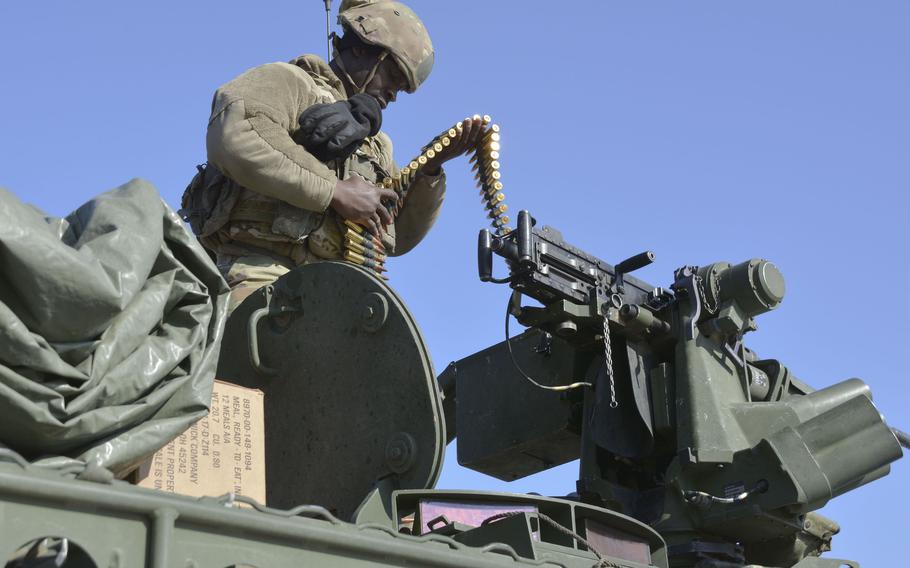
Army Spc. Daniel Howard, a cavalry scout with 8th Squadron, 1st Cavalry Regiment, 2nd Stryker Brigade Combat Team, removes unused rounds from an M-2 Browning machine gun at Rodriguez Live Fire Complex in Pocheon, South Korea, Tuesday, Jan. 10, 2023. (Christopher Green/Stars and Stripes)
POCHEON, South Korea – A Stryker brigade flexed its firepower for the first time during drills Tuesday in the snowy hills of Rodriguez Live Fire Complex, roughly 16 miles from the border with North Korea.
Around 41 Stryker vehicles from 8th Squadron, 1st Cavalry Regiment, 2nd Stryker Brigade Combat Team took part in a live-fire exercise that in previous years involved an armored combat team, including M1A2 Abrams tanks.
Last fall, the Army began transitioning to Stryker teams for nine-month rotations to South Korea with the 2nd Infantry Division.
The eight-wheeled Strykers are a “significant improvement in mobility” compared to the vehicles in the armored brigade combat teams, Lt. Col. Michael Filanowski, 8-1 Cavalry Regiment commander, told Stars and Stripes on Tuesday.
“We have the ability to go pretty much anywhere there’s a road,” he said. “We can move quick, we can move pretty quiet and … we carry more dismounted soldiers, which is better suited for the mountainous terrain of Korea.”
Tuesday’s live-fire event was the culmination of six weeks of training that included digital simulations and an exercise, Filanowski said. At the range, crews inside the Strykers identified simulated targets using cameras and thermal optics and remotely fired their mounted MK-19 grenade launchers and M-2 Browning machine guns.
Targets that represented enemy vehicles emerged from the ground up and fell after being hit by the Strykers.
Inside one vehicle, 1st Lt. Don Sparaco, of Suwanee, Ga., identified targets on a monitor for his gunner, Spc. Daniel Howard.
“On the way,” yelled Howard, a cavalry scout from Liberia, West Africa, as he fired the M-2 mounted atop the vehicle.
Sgt. Maj. Rigoberto Torres said the training was an opportunity for the Stryker crews to “gel as one.”
“Once they’re actually out in an engagement, it’s not just one soldier looking through one sight,” he said. “It’s the driver doing his part, the gunner doing his part, the [commander] mapping out wherever they need to go and finding engagement targets.”
The training comes amid renewed threats from North Korea. The communist regime fired more than 70 missiles during 36 separate days of testing last year and flew at least five drones into South Korea’s airspace on Dec. 26.
Based on the training, Filanowski said he is confident that enemy combatants facing his Stryker crews would face “the most lopsided victory of one force over another.”
“The crews … are by far the most lethal Stryker crews in the U.S. Army,” he said. “And with our [South Korean] partners, I have no doubt that we would inflict a devastating loss on any enemy that dared to threaten the sovereignty and security of [South Korea].”